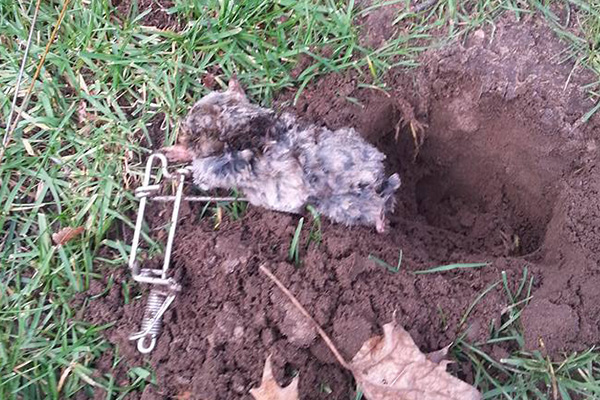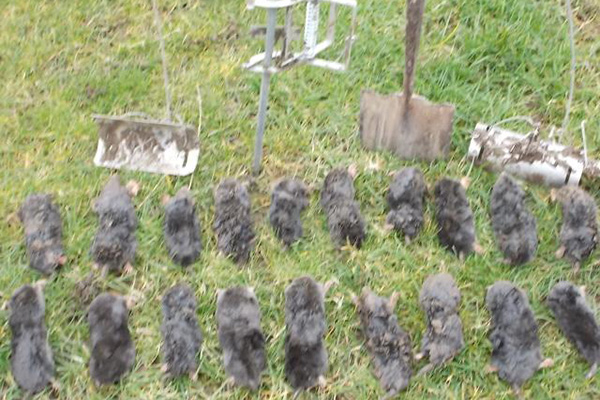- USA Wildlife Removal Education Guide and Resources
Mole Removal

While moles are content not to hurt or bother anyone, they end up doing it anyways. Moles are a thorn in the side of gardeners, landscapers and farmers and they can do some serious damage in only a short amount of time. Because moles must move and tunnel to get to the food (primarily worms and underground insects) this means that they pay little heed to things like gardens and freshly manicured lawns. What’s even worse is that moles leave behind large upturned earth called “mole hills.” Moles will also tear through your garden like its nothing; leaving shredded plant roots, flower bulbs and collapsed lawns in their path. If you or someone you know is having issues with moles, here are some do it yourself tips to get rid of these destructive critters.
- The only way to solve a mole problem is with lethal traps, such as scissor traps or harpoon traps.
- There are no live cage traps or other humane ways to catch and remove moles.
- There are no effective mole repellents or mole poisons that will affect these animals. Moles only eat live worms and grubs.
You can trap a mole the same way that you trap a mouse. You can put live or lethal traps at the entrance to their tunnels. You can bait the trap with something good to eat such as peanut butter or meats like pepperoni or sausage. If you decide to do live trapping you will need to relocate the animals several miles away from your home to ensure that they do not return.
Flooding them out is another option available to you, but some think that it is inhumane. To flood the tunnels, all you have to do is block all the entrances but one, stick a water hose into the open tunnel and turn it on. This floods the tunnels and drowns the moles. However, after you effectively kill the moles, you will still need to fill in the tunnels and take preventative measure like building a fence so that moles do not come back.
While it doesn’t do anything about the moles already in your yard, building a fence is one of the best ways to keep moles out of your yard. You can go with the traditional wooden fence or a simple wire mesh fence, but to keep out the moles, you need to make sure that it is buried at least a foot to two feet underground to make sure they do not burrow underneath of it. This is a really pricey option, but you can just build the fence around your garden or a portion of your field instead of building one around your entire property.
About Moles - Moles are subterranean rodents that are well known to people living on the North American continent. They have been the subject of children’s literature, they are known for their exceptional tunneling skills and they are one of the only animals that can survive in an oxygen deprived environment for long periods of time. Moles are strange looking creatures that have dark brown coats, powerful leg muscles and large flesh-colored paws/claws that they use to tear through the earth. Moles are solitary creatures and spend 90% of their time digging for food because they have no fat reserves and they do not hibernate. It is because of this trait that makes them so destructive.
Read about How to Kill Moles for more information about mole removal.
How To Get Rid of Moles - Tips and steps for getting rid of moles.
How To Trap a Mole - Methods for catching mole in cage traps.
Mole Prevention - Preventative methods for how to keep mole away from your property.
Mole Repellent - Analysis of various mole deterrents and repellent products.
Mole Prevention Tips - How to keep moles away from your property.
How to Kill a Mole? - When is it appropriate to kill an animal, and how.
Mole Traps - Learn about the different types of mole traps and how to use them.
How to Get Rid of Moles - The best ways to move the pests along their way.
Facts about the Mole - All about the animal that ruins your garden.
Mole Repellent - What repellents work, and what doesn't work.
What Kind of Damage Do Moles Cause to a Lawn? - What you need to know and keep and eye out for.
Mole Hills and Mole Tunnels - Learn about their habitats and how they are built.


Biology
A mole is a small mammal which is cylindrical in shape and has perfected the art of digging and living under the surface of earth. They have very small eyes and ears and their body is covered with velvet fur. They have short but powerful limbs and specially designed paws with claws that provide them with the tools they need to dig deep and long burrows. Their blood cells contain a special type of protein that helps them to survive in low oxygen and high levels of carbon dioxide. The oxygen inhaled while on ground can be stored and used for body functions during their stay in the ground. Moles also have an extra thumb, side by side with the other thumb, which is made up of a single bone without any joints. They like consuming small invertebrates, earthworms and a variety of nuts. Their saliva is toxic and paralyses their prey. They gather and store food to be used when food sources are scarcer. Researchers have found larders under the surface of the earth with thousands of earthworms kept in them for later consumption by moles. Also, before eating, the moles squeeze the earthworms between their paws to push out the mud collected in the earthworm’s gut. Certain species of moles are known to detect, catch and eat their prey in under 0.3 seconds.
Habitat
Moles are found at almost every corner of the world except a few countries. All around the world they are known to live underground in the network of tunnels they industriously create. They even search, kill and eat their prey from under the ground. They prefer open areas such as prairies and fields, but they will also make their homes in lightly wooded areas as well. They have two types of tunnels that they create; holes near the surface which are used mainly for feeding and those that are much deeper where they actually live, breed and feed. There are, however, a very few species who are known to spend a majority of their time in water.
Life Cycle
Moles generally live for around three years in the wild and the breeding season lasts between February and June. The gestation period is between four to six weeks and they give birth to two to seven babies once a year. At the time of birth, a mole weighs only three grams. Baby moles are born blind and without fur. The mother mole takes care of the babies for about four or five weeks before they go out and start living on their own. They remain active throughout the year and are not known to undergo hibernation.
Diseases caused by Moles
Moles are immune to rabies and therefore are not carriers of the disease. In fact, there is no known disease that affects humans carried by moles.
Mole Nuisances
Because of their nature of digging, moles end up destroying a sizeable portion of vegetation, which doesn’t only affect the family rose garden, but can also cause real destruction for farmers and their crops. Moles come out of the ground to surface many times in a day but each time through a different path, which creates a lot of holes in an area, making it very difficult to grow and cultivate gardens, crops and grasses. In some instances this is also a benefit as the moles churn the ground making it more fertile and aerated. However, they remove the mud from an area at a really fast pace which can cause damage to the structure of buildings by removing the mud which supports the base. Because of the many holes, some household pets and farm animals may step into one of the holes and damage a limb.

